AIR-SEA RESCUE









Station 34 (Yzerfontein) assists a family after their fishing boat is swamped by a wave near the harbour dolosse.
Station 22 (Vaal Dam) crew respond to a vessel stuck between two sluice gates at the dam wall.
How NSRI’s Water Safety Education programme has grown since its introduction in 2005.

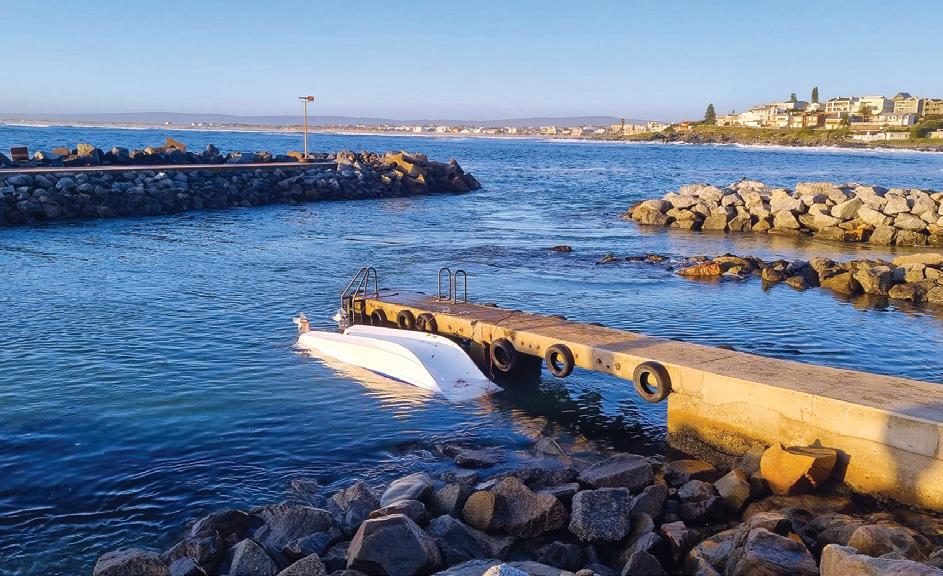
Andrew Ingram shares the drowning prevention projects closest to his heart.
22 KIDS’ CLUB
Games and water-safety lessons for our young members.
It’s been a busy time for Gqeberha crew as they assisted with a number of medical evacuations this year.
An injured hiker is assisted in Plettenberg Bay.

Station news and our Annual Awards Evening.
Naturalist Georgina Jones reveals more about sea spiders.
46 NSRI BASE LOCATIONS
CAPE TOWN:
154,
8051

T he winter solstice is behind us, and with this balmy warm berg-wind-fed weather, spring is nearly upon us. Our 2021 Integrated Report is out, so follow the link in this issue (page 37) to see a summary of our rescues and activities for 2021, a really good rebound performance after the disaster that was Covid-19.
It’s no surprise that our KwaZulu-Natal stations pulled out all the stops during the Durban floods and crews have received exceptional commendation for their actions. Our operational model is such that response or not is entirely at the discretion of station commanders and coxswains; they have the freedom of decision-making in emergencies, uninhibited by any bureaucratic or restrictive controls. The model works, as evidenced by the fact that crews recognised the threats and responded immediately in the dark and stormy night under extremely austere and challenging conditions. Rescuing 100 people out of one factory with a single JetRIB is no mean feat. As a longstanding leader in emergency services, I tip my hat to you. Well done, you do every donor, stakeholder and member proud. It’s what we do!
Two members have just returned from visits to the RNLI and Swedish Rescue Services Agency. It may come as a surprise that they have the same or similar challeng es to us in having to deal with heavy-hand ed bureaucracy and red tape. It’s always good to see what other services are up to and to benchmark ourselves.
The winter ocean safari, The Sardine Run, up the east coast was not without tragedy this year. Sharks inevitably follow the move ment of fish activity up the coast, particu
larly white sharks that predate on sardines, smaller sharks, fish and seals. Plettenberg Bay seems to have become a very busy area for white sharks (probably due to the seal colony). I was diving in Sodwana in Novem ber 2021 and a decent 3m white shark paid us a visit, and my mates at Aliwal Shoal report fairly regular sightings, so they’re all the way up the coast. The risk is there for water users and in June we unfortunately had a fatal shark-bite incident in Plettenberg Bay. An absolute tragedy! We must raise more awareness around The Sardine Run from May to August, particularly with respect to predation activity. The SharkShield seems to be a dependable product to deter sharks for a limited time and provide an opportunity to get out of the water safely.
So spring is here! We are prepping our lifeguard contracts, JetRIBs are rolling off production lines in support, and the newly instituted Suzuki Jimny vehicles will be on beaches soon. The boat stations have continued their winter maintenance and training, and new vessels are emerging from Gemini Marine and Two Oceans Marine. The Wild Coast programme is progressing steadily and we’re gradually expanding our presence at dams, and our next inland service offering will be at Gariep Dam.
Congratulations to all the award winners from the AGM. Kudos to all of you, and congratulations to all the stations who are driving service quality up across the country and the coast.
Remember to wear your lifejacket, always. Keep your kids within reach near water and have a safe experience wherever you are.
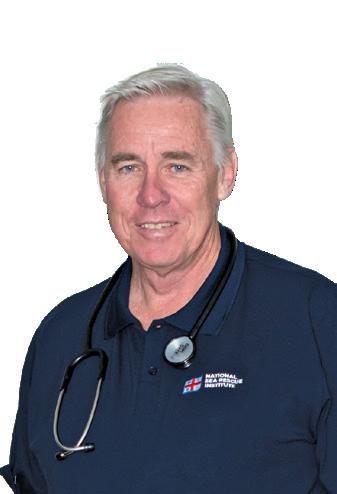













THE PUBLISHING PARTNERSHIP
MANAGING EDITOR
Wendy Maritz
ART DIRECTOR Ryan Manning
ADVERTISING EXECUTIVE

Bernice Blundell
EXECUTIVE DIRECTOR
Mark Beare
PRODUCTION DIRECTOR
John Morkel
MANAGING DIRECTOR
Susan Newham-Blake
ADDRESS
PO Box 15054, Vlaeberg 8018
TEL +27 21 424 3517
FAX +27 21 424 3612
EMAIL wmaritz@tppsa.co.za
NSRI OFFICE +27 21 434 4011

WEB www.nsri.org.za
FUNDRAISING AND MARKETING DIRECTOR

Janine van Stolk
janine@searescue.org.za
MARKETING MANAGER
Bradley Seaton-Smith bradley@searescue.org.za COMMUNICATIONS & PR MANAGER
Kuhle Mkize kuhle@searescue.org.za
PRODUCED FOR THE NSRI BY The Publishing Partnership (Pty) Ltd, PO Box 15054, Vlaeberg 8018. Copyright: The Publishing Partnership (Pty) Ltd 2022. All rights reserved. Reproduction in whole or in part is prohibited without the prior permission of the editor. Opinions expressed are those of the authors and not the NSRI. Offers are available while stocks last.
PRINTING Shumani RSA
ISSN 1812-0644
Recently my husband, Bertus, my father and our eightyear-old son, Christian, went to Dassen Island. And like so many times before, Bertus only goes out to sea when the weather and water is perfect, annoying us with safety brief ings that we have heard so many times. We went out after 8am and caught two yellowtails. We were happy with one for the coals and one for the freezer and probably started heading back to Yzerfontein around 12.30pm.
Bertus followed his route on the GPS like every other time. He always does everything right and never takes chances. We saw Meeurots far ahead to the left and the dolosse ahead on our right. Bertus was aware of waves to our right, but when I looked to the left I stared into a two-storey swell and screamed. The water was right above us, then over us and we capsized. I got out first and saw the boat in front of me, swam to it and grabbed hold. I saw my dad swimming towards me. Then Bertus emerged, choking on water. All I could do was shout, ‘Where is my child! Go and find my child!’
Bertus and my dad start taking off their jackets and shoes so they could swim under the boat and look for Christian. The next moment my child’s face appeared next to my husband. He had been stuck under the boat in an air pocket. He was so smart and realised he must get his life jacket off to be able to swim out from under the boat. We all got onto the hull of the boat and then I realised my phone was in my jacket pocket. I called my mother and then the NSRI for help.
We watched every wave that approached with fear. Bertus said we will have to be ready to jump off and swim if we get too close to the rocks. Then the NSRI arrived. They threw a rope to us to pull us to safety first. When we were well away from the dolosse they picked us up and took us to the harbour. We were welcomed by the NSRI with blankets and led to showers.
We are amazed at God’s grace and that all four of us survived this experience unharmed. It was a miracle. We are incredibly thankful to the NSRI. And also to the people of Yzer for their caring hearts.
DORITA ENGELBRECHT



FROM ONE OF OUR

Hi, I am Ruben and I love sea life.

I hope the release of the turtles and dolphin go well.
I have an encyclopedia of sharks by Miles Kelly. I am happy that you take care of the animals in the ocean. When I grow up I want to be a marine biologist and protect all sea life. Thanks for everything you do. Ruben
The writer of the winning letter published in the next issue of Sea will receive an NSRI hoodie.

Email your letters to magazine@ searescue.org.za or post them to Sea Rescue magazine, PO Box 15054, Vlaeberg 8018. (Letters may be shortened and the winning letter is chosen at the editor’s discretion.)




The RSA SafeTRX App monitors a boats journey and alerts emergency contacts, who are nominated by the user (family and friends), should they fail to return to shore on time. This free cellphone application, enables the user to plot their intended course, store essential emergency numbers that can be used by NSRI if you fail to return from your trip, gives NSRI your location at all times during your trip, gives the user the ability to call an emergency at the push of a button and provides the NSRI with your exact position throughout our rescue response if you press the emergency button.











A morning of fishing near Dassen Island off the Cape West Coast turned into a nightmare for a family whose boat capsized near the dolosse at Yzerfontein Harbour. Cherelle Leong recounts the group’s harrowing ordeal.

IT WAS THE JULY SCHOOL holidays and the weather apps for Yzerfon tein predicted good weather for Wednesday 6 July. The Englebrecht family launched in the morning for a fishing outing and headed out towards Dassen Island. As they had many times before, they followed the familiar route to their favourite fishing spots. On board were three generations, Otto van der Merwe, an Yzerfontein resident, his daughter Dorita, her husband Bertus, and their eight-yearold son, Christian, who was hoping to catch his first fish.
As the day wore on, the weather conditions started to deteriorate with a northwesterly wind picking up, indicating a change in weather. By midday the family decided to head back to Yzerfontein. Christian had been successful with his first catch of a yellowtail and there was no reason to stay out on the water any
Heading to Dassen Island for a morning of fishing.
longer. The sea had turned choppy by the time the family neared the harbour and when they were midway in their approach, a wave suddenly rose up next to them.
The family had no time to prepare as the wave crashed down, capsizing the vessel and flinging everyone into the cold water. One by one the three adults surfaced and Dorita, who had reached the capsized vessel first, was relieved to see her husband and father swimming towards the upturned hull.
But with alarm Dorita soon realised that her son was nowhere to be seen. He’d been wearing a bright orange lifejacket but it wasn’t visible anywhere in the churning sea. A fear she’d never experienced gripped her. They had to find Christian. Bertus and Otto had just started removing their shoes and some clothing to dive under the hull of the boat to search for him, when a small head emerged from under the boat. It was Christian, smiling, very pleased to be reunited with his family.
But with alarm Dorita soon realised that her son was nowhere to be seen. He’d been wearing a lifejacket but even the bright orange of the lifejacket wasn’t visible anywhere in the churning sea.
Eight-year-old Christian Engelbrecht delighted with his first catch!

everyone else was flung out. Fortunately, he’d found a space where there was a small pocket of air. After catching his breath, he’d tried to dive down and swim out from under the boat but the buoyancy of his life jacket kept preventing this. He quickly realised if he wanted to get out and be reunited with his family, he’d need to take the lifejacket off. After untying it, he took a deep breath and pulled himself under, holding onto the up turned hull as he felt his way out. Perhaps it was this sense of accom plishment that led to the grin as he emerged from the water.
When the boat had gone over, he’d held on tight and remained inside the hull when
Dorita’s sense of relief was immense: seeing her son alive and well was a moment she’ll never forget. One by one the family climbed up onto the upturned hull, relieved that they were all safe and accounted for. Their sense of security was shortlived though. The current and swells were quickly pushing them closer to the massive concrete dolosse that line the har bour wall. They weren’t out of danger yet.
It was a treacherous corner to be stuck in, with waves pounding from all sides. They could stay on the upturned hull for a short while but if the current took them much closer they’d have to jump or be smashed up against the dolosse along with the boat. Except this time Christian wouldn’t have a lifejacket on and it’d be up to the adults to hold on and help keep him safe in the churning sea. Dorita doubted her ability to do this and knew they needed to get help.
As they were debating their options when Dorita felt her phone in her pocket. Thinking it would be waterlogged and of no use, she took it out anyway, and was surprised to find it was still working. She looked up NSRI Yzerfontein’s emergency number and quickly explained what had happened and that they needed the NSRI’s help, fast. After making the call, they could do nothing but wait. It felt like an eternity until her phone rang and a crew
member told them that help was on the way. For Christian, his biggest concern was whether the yellowtail he’d caught earlier would still be on the boat.
The upturned hull with the Engelbrechts was indeed drifting dangerously close to the harbour wall; the NSRI would have to launch immediately.
Héléne van Zyl, an Yzerfontein crew member, happened to be at the base when the call came through. She quickly activated the crew to respond and called André Livingstone-Louw, the duty coxswain. The upturned hull with the Engelbrecht family was indeed drifting dangerously close to the harbour wall; they’d have to launch immediately.
Back at the station the crew wast ed no time launching. It had been just over 15 minutes since the call had come through when they exited the harbour. The casualty vessel had already drifted into the danger zone where there was little room to manoeuvre. Trying to come alongside to get them off the upturned hull would be extremely challenging. André knew that

Left: The family is assisted onto the rescue vessel. This page: The upturned hull is secured.
the safest option would be to get them away from the harbour wall first. The crew had a towline prepped and ready, they just hoped the casualties would be able to connect it.
Approaching cautiously, the NSRI crew shouted they were going to throw a line, signalling to Bertus and Otto to attach it to the towing eye. As the hull was drifting closer to the dolosse with every minute that went by, it was critical to get the towline attached as quickly as possible. They’d only have one throw attempt. Fortunately, this went according to plan and as soon as the towline was connected the rescue vessel proceeded to slowly tow the upturned hull with the family still on board, away from the harbour wall. Once in calmer waters, the towline was detached and all four casualties were evacuated off the upturned hull onto the rescue vessel. With the risk of hypothermia, they were taken straight back to the base to be medically assessed and warmed up. On the jetty they were met with blankets and ushered inside the base to warm up and take a hot shower.
While crew at the base took over care of the family, André and his crew returned to the capsized boat that was adrift just outside the harbour. It was so waterlogged that attempts at sea to right it were un successful. They then towed it to the jetty and slipway so that it could be recovered from the water.
For the Engelbrecht family, recovering the boat was the least of their concerns. The biggest relief and most important thing was that they were all safely on land, their family intact. The outcome could have been very different. Now there is a chance for other fishing days and hopefully many more family memories in the making.
For young Christian it was a day of many firsts, some of which his family hope never to repeat. His sharp thinking and bravery in getting himself out from under the hull all on his own is certainly what stands out – a feat many adults may have struggled to achieve. Well done, Christian, on your amazing display of courage in getting out from under the hull.

AT THE START OF 2022, the Gauteng region experienced excessively high rainfall and by April the Vaal Dam was at 115% capacity. The Department of Water and Sanitation systematically opened a few sluice gates in the dam wall to manage rising water levels. Each sluice gate, when opened, is capable of releasing 115m3 of water per second. It was when two of the sluice gates were open that Jake Manten, station commander at NSRI Vaal Dam, received a call from a passerby. The person reported that a ski boat was caught up against the dam wall, directly between the two open sluice gates.
This was the type of call that Jake had been dreading. The area near the dam wall no longer had safety cables to keep boats away. The fast-flowing water wasn’t the only concern: on the other side of the dam wall, the water cascaded down a
height of 90m. Anyone swept through the open sluice gates would have little chance of survival.
As the crew prepared to launch, Jake made a call to the Department of Water and Sanitation, asking them to close the sluice gates to slow the flow of the water. Fortunately there were staff on site who responded immediately. By the time the crew arrived on the scene, however, the water was still flowing so fast that it was not safe yet to approach the casualty, who was holding on to the dam wall to avoid being pulled through the open sluices on either side. The casualty, a new boat owner, found himself in this dangerous position after engine failure had caused him to be swept towards the dam wall.
The station’s 7.5m RIB stood by at a safe distance from the dam wall while waiting for the water flow to slow enough
to approach the strick en ski boat. Everyone was briefed and ready – there’d be no mar gin for error once they started their approach. When it was estimated the flow had slowed to about 8 knots, the rescue boat headed towards the casualty. A towline was rigged to the bow of the res cue boat, with a crew member ready to assist the casualty. They couldn’t be sure whether they’d be able to attach a towline, so the contingency was to evacuate the casualty onto the rescue vessel if the tow couldn’t be established.
The bow of the rescue boat was used to pin the casualty vessel up against the wall while
of the dam wall, the water cascaded down a height of 90m. Anyone swept through the open sluice gates would have little chance of survival.
a crew member boarded it quickly to attach the towline. Then, once connected, the RIB careful ly manoeuvred astern, pulling the casualty vessel away from the dam wall. Once safely out of the current, the towline was moved to the stern of the rescue boat to tow the casualty back to shore. The rescue manoeuvre took no more than five minutes, but for Jake it was the longest five minutes of his life –helming astern with the knowledge that everyone’s lives were in his hands was not an experience he’ll quickly forget.


 Station 22’s rescue craft approaches the casualty vessel with caution.
Station 22’s rescue craft approaches the casualty vessel with caution.
The NSRI’s Drowning Prevention Department continues to work tirelessly to bring water safety education to the communities where it is most needed. We chatted to drowning prevention education coordinator Valerie Barlow and two new water safety instructors who have discovered their passion for empowering young children.
By Wendy MaritzSINCE IT WAS FORMED in 2005, the NSRI’s Water Safety Education Programme has aimed to empower previously disadvantaged communities to be safe around water. In the early days, the programme consisted of only a handful of instructors who targeted schools in the Western Cape.
Instructors would visit schools armed with colourful visual materials to teach ba sic water safety. Children were also taught not to run away from an emergency, who they should call in an emergency and also told that they should never put themselves in harm’s way trying to help a friend. They were also shown how to make basic flotation devices using 2-litre milk bottles tied with long rope that could be thrown to someone struggling in the water.

‘By the end of 2006, the pro gramme had reached 6 500 learners who were taught what to do when they or a friend got into trouble in the water,’ says drowning prevention education coordinator Valerie Barlow.
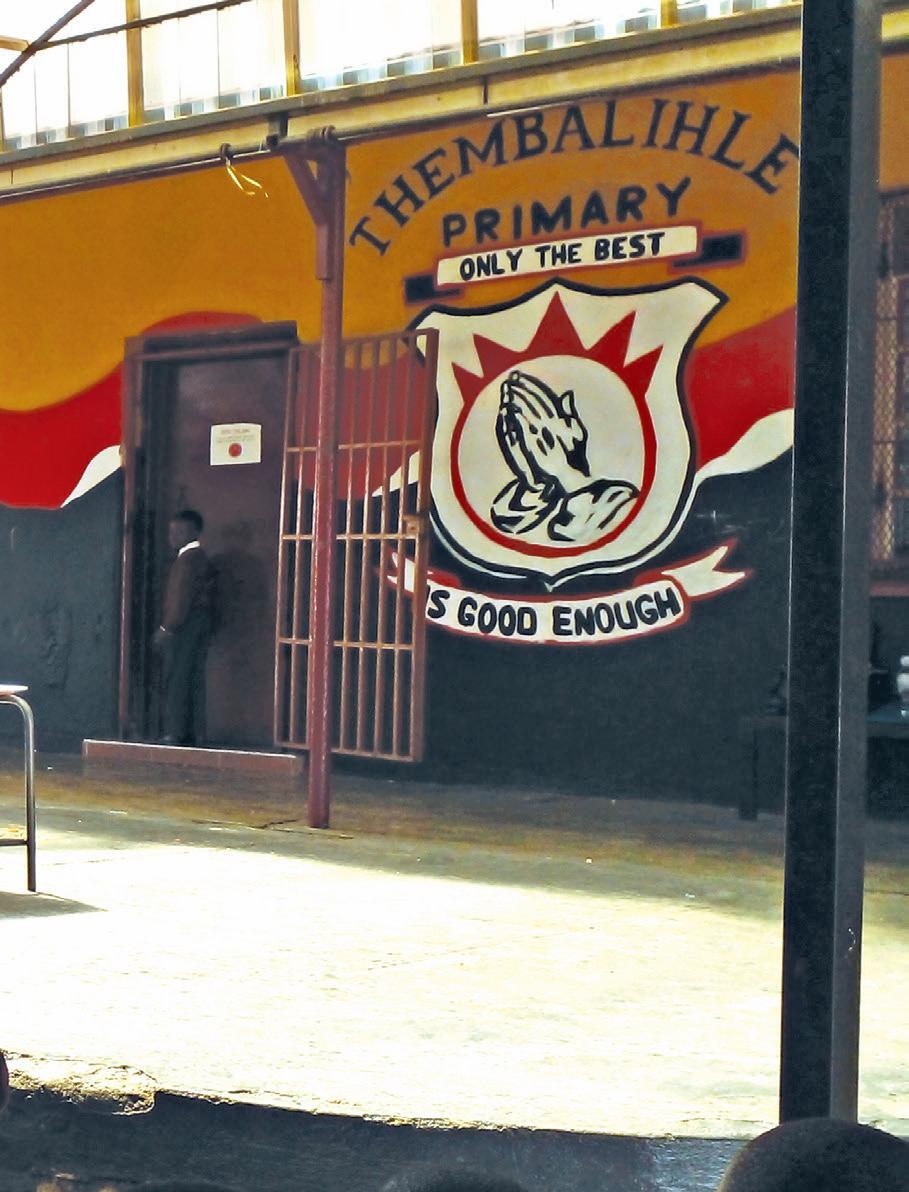
The water-safety instructor complement has since grown to 31, distributed around the country as follows: two in Gauteng, nine in KwaZulu-Natal, 12 in the Western Cape and eight in the Eastern Cape. This number includes three team leaders. In

addition, there are administrative staff, based at NSRI’s head office, who work to support those out in the field.
These are all individuals passionate about water safety and empowering children. They understand the bigger picture and how drowning deaths can affect families and communities long after the event itself has passed.
Bernice Cook, who joined the team on 25 May 2022, knows from first-hand expe rience how frighten ing water can be.
‘I could never swim,’ she says. ‘I grew up in foster care and children’s homes, and remember the time I was pulled under the water and nearly drowned. I prayed that one day I would learn to swim, and once I could, my mission was to help whoever I could and give back to the community.’
Bernice is based at Hanover Park Swim ming Pool in Cape Town during summer, and in winter, she works at Long Street Swimming Pool in the city centre. She also covers schools in Athlone, Rylands, Manenberg and Lansdowne. ‘I love teach ing children and adults,’ she says, saying it’s amazing to see them ‘achieve some thing that they might never have thought possible. The smiles and hugs of gratitude bring tears to my eyes sometimes, but
they make getting up in the morning and doing my job so worthwhile.’
Bernice notes with a smile that even when she is not on duty, and simply walking in the neighbourhood, she’ll hear, ‘Hallo, Aunty Bernice,’ or ‘THAT’S the aunty who taught us at the school or pool!’
Linda Dalamba, an educator in Gauteng, has a similar reaction. The children love the 112 song she teaches them, even devising a dance to go with it. When they see her out and about at the shops and recognise her, they start singing the song. While this is certainly gratifying, it means that the children are retaining the information she is teaching them. Knowing the emergency number is crucial information.
Instructors have a host of teaching materials at their disposal, and arrive at classes armed with plenty of audio-visual materials to aid their teaching tasks. Over the years, the department has created characters that the children can relate to: in particular, Nev the turtle and Peggy the penguin. Peggy wants to go swimming all the time even when it’s dangerous and Nev has to constantly tell her she can’t.

Top: Linda has a captive audience. Above: Bernice brings the lesson to life with visuals that help to illustrate various aspects of water safety.

‘They get excited,’ she says, ‘and all of them, like Nev, want to warn Peggy not to get in the water.’ For the older children, the fascination lies with CPR. But what most of them have in common is that they have never been to the ocean and don’t know what a rip current is. Linda says the children find this so interesting, and can’t stop asking questions.
‘Seeing the children listening, asking questions and hearing them say, “I didn’t know that”, is reward enough for Linda,
but she adds that it’s particularly gratifying that the teachers also want to attend the lessons.
Linda taught swimming for six years, but never got the chance to teach in her own neighbourhood. ‘There are limited resourc es and little chance for formal swimming lessons to take place. There are high incidents of drowning, but through this programme more children will learn to be safe and know what to do if a friend gets into trouble in the water,’ she explains.
‘Instructors are appointed according to priority areas,’ says Valerie. ‘These areas are identified using historical data on drownings as well as where large num ber of bodies of water are situated. We know all too well that drownings can occur anywhere and so for this reason, we also approach clinics, youth groups, creches and churches to offer instruction.’
But it’s in schools where the largest numbers of children can be reached. ‘The lessons are also personalised to give significance to the area where the target group lives,’ Valerie adds. For example, for a family living in a rural community where there is no piped water, the lesson is geared towards the safe collection and storage of water in buckets, while swim ming pool safety would be emphasised in urban areas.
During 2019, the year before Covid-19 struck, NSRI’s Water Safety Department reached 574 099 people. During the pandemic, instructors continued as best
they could via TV, radio and online classes. While the target of reaching 600 000 people this year is on track, the technol ogy that was relied upon in the absence of face-to-face classes is still being used. ‘Instructors use social media to spread ap propriate messages to prevent drowning, with infographics, videos and news being shared to highlight current trends, like weather patterns, holiday seasons, and so on,’ Valerie says.
NSRI’s Drowning Prevention Department works in line with World Health Organiza tion recommendations, which has grown
Instructors use social media to spread appropriate messages to prevent drowning, with infographics, videos and news being shared to highlight current trends, like weather patterns, holiday seasons, and so on.
to include in-water lessons. During the last few years, this has seen the introduction of NSRI’s Survival Swimming initiative that teaches children and adults at public swimming pools how to propel themselves to safety without panicking should they find themselves in deep water. This in cludes breath control, orientation, floating and moving through water.
‘Through a process of constant evaluation and development, the Water Safety Education Programme will continue evolv ing to ensure that the best techniques of teaching and skills-sharing will be used to keep the people of South Africa safe around water,’ Valerie concludes.
Following the success of the first beach safety camera at Strand, which has been used to help rescuers during a number of operations as well as identifying rip currents and helping Strand Lifeguards to keep their beach safer, a second camera was put up at Blouberg, deemed one of Cape Town’s most dangerous beaches. It has helped with kitesurfer rescues and, in one case, ascertained that a flare that was sighted had in fact been fired from the beach, thus saving crews the trouble of launching for a futile search.
Now we can monitor the beach from the NSRI Emergency Operations Centre (EOC) in Cape Town or from a responder’s mobile phone.
Recently a third camera has been made operational in Herolds Bay close to Wilderness. Possibly among the most dangerous beaches on the Garden Route, this is one of the spots where Station 23 has deployed a small rescue craft to allow quicker responses to a drowning in pro gress. As lifeguards are only on duty here during the season and rip currents are a constant danger, some out-of-the-box thinking was needed to get a rescuer to a person in a rip as fast as possible. Pink

Rescue Buoys are deployed on the beach to assist in a bystander rescue (a number of lifeguards and NSRI rescue swimmers live here) and now we can monitor the beach from the NSRI Emergency Operations Centre (EOC) in Cape Town or from a responder’s mobile phone.
Now, for the first time, responders can get an accurate up-to-the-second account of the status on scene while they are responding to Herolds Bay.
Our first Survival Swimming Centre (SCC1) has now been operating for a term at Meiring Primary School in Riebeek-Kasteel. During this time, NSRI instructors have taught more than 400 lessons and 13 children have passed the Survival Swimming Course – this means they are able to control their breathing, orientate themselves in the water, float and move through the water for at least five metres.
As winter arrived, the air temperature dropped to below 10˚C in the valley and the water in the SSC1 dropped into the low teens, making it way too cold to swim in. This was quickly rectified by a heat pump that Fluidra donated, which raised the temperature of the water to a toasty 28˚C, allowing children and instructors back into the water during winter!
Using the lessons learnt during the build of SSC1, we have made some minor adjustments to SSC2 but the basic equip ment will remain the same. It will be a 15 000-litre pool (filled with water donated by the local municipality) that will be topped up when needed from rainwater
sky’ at Herolds Bay.
Top: A truck delivers the container swimming pool. Above: The second Survival Swimming container.


collected from the roof in a JoJo tank. The filtration and circulation systems, the mon itoring of the water quality and tempera ture, as well as the camera systems are all top quality and mostly donated by caring companies involved in the industry.
If it weren’t for the incredible buy-in from this small group of companies and peo ple who work for them, this project would not be possible. A special thanks to Delve Aquatic Systems, Dibana Logistics, Fluidra, Metalo, Mr Water Delivery, NCS Resins and Pools for Africa – without you this dream would not have become a reality.
And a huge thank you to Speedo Swim United who have come on-board as our first title sponsor for SSC2.
Fun, games and lessons for our younger members.
Congratulations to Lynsay Windvogel from Wellington for completing the Find the word game from our Autumn issue. Lynsay wrote a story using all the words she found.
Meandmybuddylike to swim and dive in the waves or sometimes in the pool. We sometimes see lifeguards running with their flags.Theywantustobecareful because the watermaybedeepandwecouldendupdrowning When there is an emergencytheywillhelp,andtheyalso have whistles to warn us. Sometimes when we are in shallow waterweliketokeeponswimming. Attheendofthedaywealwaysenjoyourswim.
Well done for using all the words, Lynsay! Your hamper is on its way to you.
The words run up or down, side to side or slanting.

Buoy Rescue Waves Rocks
Pink Be safe Beware Water
U
Y B
X E W A T E R
K S S R H W O
N A Z C M A C
I F P Q U R K
P E W A V E S
Water-safety questions for your game. Turn the page to see how to play.
1. What number do you call in an emergency or to get an ambulance?
112
2. What dangers are there in the water?
Rocks, holes, waves, sharp objects
3. What must you do before you go swimming?
PLAN
4. What does each letter in PLAN stand for?
Pack
Look
Ask
Never swim alone
5. What do you pack before going to swim?
Bathing costume, sunblock and water
6. Can you ask your little brother or sister to go swimming with you?
No
7. Who do you ask to go swimming with you?
A responsible adult
8. Are you allowed to push someone into the water?
No
9. Are you going to run away if your friend is in danger?
No
10. What do you do when your friend is in danger?
Call for help.
11. Can you reach over the water to try help your friend?
No
12. What do you do if your friend has fallen in the water Call for help OR see if there is a long stick you can use to help pull them out.
13. Are waves dangerous and why? Yes, they are. They can knock you over.
14. Can you go swimming on your own?
No
15. Why are rocks dangerous? You can slip and fall and hurt yourself.
16. Are your parents allowed to text on their phones while you are swimming?
No
17. Is it dangerous to swim in rivers and dams and why?
Yes, dams and rivers often have muddy water so it’s difficult to see how deep it is or whether there are sharp objects on the bottom. Also, rivers can flow very fast.

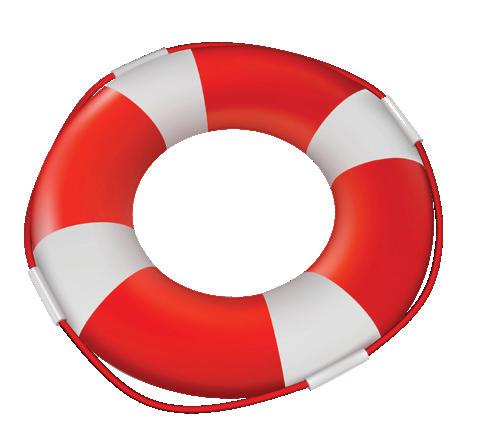
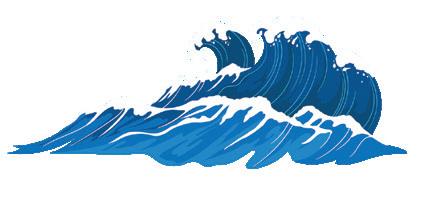








RULES: RULES: You play this game like Snakes and Ladders. Starting at block 1, your aim is to get to Peggy in the last block.
1. Place your stones on block 1.
2. Roll the dice. Whatever number it lands on is the number of blocks you move.
3. If you land on a crab or a fish, you have to answer a water-safety question from the list on the previous page.




4. If you answer correctly, you stay on your block.
5. If it’s wrong, you have to move back three spaces.
6. If you land on a whale’s tail, you can slide up the whale to where its head is and place your stone there.

7. If you land on a shark’s head, you have to move down his body to the bottom of his tail fin.


Hoorah! You can move to block 28!
Station 6 (Gqeberha) crew have been involved in 18 medical evacutions this year alone. We chatted to station commander Justin Erasmus about what’s involved in these operations. By Wendy Maritz
IN APRIL THIS YEAR, Station 6 (Gqeberha) crew responded to a fishing vessel from Mossel Bay that was heading towards the city’s port from fishing grounds south of the coast. There had been a fire onboard, which had been
contained and extinguished, but an injured fisherman needed medical attention urgently. The station launched Spirit of Toft and rendezvoused with the fishing vessel. NSRI medics boarded the vessel and continued with the medical treatment

Spirit of Toft approaching in the lee created by a bulk carrier.
that had been initiated by the casualty’s fellow crewmen. Once stable, he was transferred to the rescue vessel and brought to Station 6’s medical room, after which he was transported to hospital by a Netcare 911 ambulance for treatment.
On the face of it, it was a slick operation that ensured the injured casualty received timeous and proper care in the hands of professionals. But Station 6 (Gqeberha) station commander Justin Erasmus will tell you there are a number of ‘moving parts’ involved in a medical evacuation including sea states and weather conditions, which are always an issue when embarking on any callout.
This is why standard operating proce dures are so important. ‘For all medevacs, we have an EMS medic to look after the patient, two maritime extrication (MEX) specialists, two rescue swimmers, a deck controller, a navigator/radio operator and a coxswain onboard,’ Justin explains. It’s not difficult to see why this amount of expertise is needed when one considers the types of scenarios the crew faces. ‘Medevacs usually mean someone (or a group of people) is either severely injured or sick, and needs treatment at a medical facility. We’ve seen lacerations, ampu tations, burns and crushed limbs. Other scenarios include heart attack, stroke, ap pendicitis and, in recent years, Covid-19.’ Justin recalls one callout that involved five injured crewmen. ‘They were so severely injured that we made a call to bring the ship to port so we could extricate them

there as the weather conditions made it impossible for a safe medevac out at sea.’

Another one that springs to mind as a challenge was a callout on 19 March to assist a casualty who had suffered a stroke. ‘After reaching the vessel, the EMS paramedic went to attend to the patient, after which an attempt was made to transfer him to the rescue vessel, but it was deemed too dangerous,’ Justin says. ‘The vessel was instructed to continue towards Port Elizabeth. The patient began deteri orating rapidly and, on the advice of the paramedic, the decision was made to evacuate the patient at our satellite station at Noordhoek. (The ambulance waiting in the port was then sent to the new location.) Once there, the patient was transferred to Rescue 6A and brought ashore through the surf line. It was one of those rescues where we really made a difference!’
Following standard operating procedures is essential for the safety and success of a medevac. ‘With the SOP we have things covered,’ Justin says. ‘Sometimes com municating with foreign vessels can be tricky, but we try to get as much infor mation as we can about the patient’s condition, so that we can escalate efforts, like requesting a helicopter, if necessary. Once on scene, use is made of the ship’s pilot ladder and gangplank to board the vessel and/or to transfer the casualty from the main vessel to the rescue craft. If the casualty is able to walk, they are placed into a safety harness with a safety rope attached, and then guided down the pilot’s ladder. If unable to walk, the patient is secured in a stokes basket, and then by means of a set of ropes and pulleys is low ered down the side of the ship. The system we use is doubled in case one set fails. We also make use of a handsfree braking system should something go wrong.’
It goes without say ing that those attending medevacs require technical know-how, skill and stamina to be able to successfully bring an injured casualty to safety. Every week Station 6 crew practise some kind of formal mari time extrication training that includes high-angle rescue work. So far this year, crew have been called out to 18 medevacs, with the station averaging about 30 of these types of callouts per year.
Station 14 (Plettenberg Bay) was called to assist an injured hiker who’d taken a nasty fall on a trail. Cherelle Leong tells the story.
IT WAS JUST BEFORE 2pm on Sunday 10 April when Station 14 (Plettenberg Bay) was activated for a call. A hiker had been injured near the end of a hiking trail at Cairnbrogie Farm in the Kranshoek area. The group had completed the main hiking trail and had decided to go for a swim, which involved climbing down a cliff along a steep rocky path to get to the water.

It was a challenging route on tired legs but fortunately a guide rope runs alongside the trail to help hikers to steady themselves. Bianca Habib was following her friends along the trail when she stepped down a steep incline and held onto the rope for support. The rope went slack, and she lost her balance, landing on a straightened left leg and twisting her knee in the process.
Deputy station commander Laurent Eray responded to the scene in the base mobile, along with crew members Matthew Leppan, Nathan Hart and Wihann Kotze. The information they received was that a hiker was injured on the trail, not far from the parking lot. They were hoping they’d be able to carry her out, but the final decision would be made after assessing the situation first-hand.
On reaching the parking lot, Matthew, Nathan and Wihann grabbed the medical kit and handheld radio, and prepared to hike down the trail to where Bianca was located. Once they started descending, it quickly became apparent that it would be too dangerous to attempt to carry any casualty out of there. The trail was too steep and rocky, and she was much further down the trail than initially anticipated. While the crew worked to assess Bianca’s injuries and stabilise her, they communicated to Laurent that an alternative evacuation plan would need to be made. Bianca had injured her knee quite badly and couldn’t place any weight on that leg. Because carrying her back up the
trail had already been ruled out, a helicopter hoist was the only option.
A request was placed with AMS for assistance and they were activated to respond to the scene. In the meantime the NSRI crew worked to prepare Bianca for transport. It helped that Matthew knew Bianca’s husband, Ryan, and they were able to keep a conversation going while waiting for the helicopter. With news that AMS was on its way, the rest of the hiking party climbed back up the cliff path to the parking lot. A landing zone had already been set up there for the helicopter, with the NSRI crew on standby to assist.
The AMS helicopter proceeded to hover near the cliff and hoisted two EMS rescue technicians down to where Bianca was located. Once they’d completed their assessment, the hoist was called for. With her injured leg stabilised, Bianca was secured into a seated strop and hoisted up into the AMS helicopter along with one of the EMS rescue technicians. Once they were safely on board, the helicopter delivered them to the landing zone to meet up with Ryan, who was waiting there. The EMS rescue technician who had accompa nied Bianca continued treatment to ensure that she was comfortable. Meanwhile the helicopter returned to collect the second EMS rescue technician, who’d stayed behind with the NSRI crew. As the day drew to a close, the remaining NSRI crew hiked back up to the parking lot.
The AMS helicopter then transported Bianca, accompanied by both EMS
When she lost her balance, she reached for the guide rope but grasped air instead…
Rescue technicians from AMS and NSRI crew prepare Bianca to be hoisted into the helicopter.

technicians, to a Knysna hospital where she was admitted for further care.
Bianca saw an orthopaedic surgeon the following week, after a few days of rest to allow some of the swelling to subside. An MRI scan confirmed that the injury was quite severe and would require surgery – she had completely torn her anterior cruciate ligament. In addition, she was suffering from a torn meniscus and her
tibia was bruised. Eight weeks after the complex surgery, Bianca reported that she was in good health. She was undergoing intense physio rehabilitation and getting around on crutches. She hopes to make a full recovery in time and has ex pressed her gratitude to everyone involved in the rescue. Because the acci dent happened in the early afternoon, there were only a limited number of daylight hours to work with. The availability of the AMS helicopter to assist with an aerial evacuation result ed in a very efficient and safe rescue. Without an aerial rescue, the only option would have been to try to carry Bianca out. The steep, rocky and narrow cliff path would have made this very challenging and time-consuming, and treacherous to attempt in the dark. The NSRI is very grateful for the close working relationship it has with AMS, whose assistance made this rescue successful.
THE NSRI Pink Rescue Buoy project was started in late 2017 and is now, after 121 rescues, entering a new phase. The World Health Organization has published three documents concentrating on drowning in which it recommends that citizens are taught safe peer rescue techniques and how to do CPR (the first was published in 2014 and most recent in 2022). These publications have stimulated an interest in public rescue equipment, which, at last, is something that is being taken seriously around the world.
Following the success of the Pink Rescue Buoys, there has been serious interest in our programme from Surf Lifesaving New South Wales, Surf Lifesaving New Zealand (which has 25 Pink Buoys in use around Auckland) and there are Pink Buoys in Mozambique as well as Ascension island.
Following the success of the Pink Rescue Buoys, there has been serious interest in our programme from Surf Lifesaving New South Wales, Surf Lifesaving New Zealand (which has 25 Pink Buoys in use around Auckland) and there are Pink Buoys in Mozambique as well as Ascension island.
Following our extensive data collection regarding the use of public rescue equipment, the evidence shows overwhelming ly that people go into the water to help someone in danger of drowning despite being advised that this is dangerous.
While working with Lifesaving New Zealand’s National Coastal Safety manager, Dr Mick Kearny, and during our constant monitoring of similar public rescue equipment programmes around the world including Hawaii’s Rescue Tube pro gramme, the NSRI has found that the data from New Zealand and Hawaii also show that almost all public rescue attempts involve would-be rescuers going into the water to help. And, importantly, that there are no known injuries to people who take emergency flotation with them when they enter the water to assist someone.
The Hawaii Rescue Tube programme (which has 600 tubes deployed in Hawaii, the US mainland and Canada) articulates their results in the same way that we do:
‘All known rescues were successful and no rescuer has been injured using one of these rescue tubes.’
We have therefore decided to change our approach and wording on the Pink Rescue Buoy public rescue equipment programme, as follows:
››
Pink Rescue Buoys are designed to be available as emergency flotation for anyone to use to protect themselves
while they attempt to help a swimmer in distress. They are not to be used or intended as swimming or flotation aids for people who want to just go for a swim – they are for emergency rescue use only.
›› A Pink Rescue Buoy has been used to rescue 121 people that we know of (as of Mid-August 2022). All attempted res cues have been successful and no harm has come to a rescuer who has used a Pink Rescue Buoy as emergency flota tion to help a swimmer in distress.
›› Always swim near lifeguards when pos sible. When not, Pink Rescue Buoys are there for all of us. Let’s enjoy our beau tiful rivers, dams and beaches safely!
Pink Rescue Buoys do not indicate the presence of a safe swimming area – in

››
fact they are often placed at locations with rip currents or other dangerous swimming conditions.
If you are not a strong swimmer do not use this emergency flotation. Do not go into the water. Rather, throw it to the person in distress.
›› Get others involved in the rescue, call NSRI (112), shout and be noticed.
››
Strong swimmers should put the strap over their shoulder, swim to the distressed person and pass the Pink Rescue Buoy to them. Do not allow the person in distress to grab hold of you and, for your safety, do not make physical contact with the person who needs help.
››
Wait to be rescued by lifeguards (if present).
LONG-TIME NSRI supporter Roger Hogg from KwaZulu-Natal is now the proud owner of a Mitsubishi ASX 2.0L. Roger, who works in the shipping and logistics in dustry, is well aware of the important work the NSRI does and has been buying Car Competition tickets for about 12 years. He admits that when he was informed he was a winner, he thought someone was playing a joke on him. ‘I’m a practical joker, so I

Stewart Seini was recently invited by the Royal National Lifeboat Institution (RNLI) to visit them in the UK on an informa tion-sharing trip. ‘The aim was to share information regarding our processes and operations, to learn from each other, and build operational procedures endorsed by both organisations,’ Stewart explains. He spent the first week at the RNLI training and support centre in Poole, where he attended the lifeguard operational leadership course and met with members from the lifeguarding departments. He also spent a significant amount of time with the train ing department as they ran through vari ous lifeguard courses aimed at increasing
often play pranks on my friends,’ Roger laughs. ‘But when they called me again, I realised it was real and I was delighted. I still can’t believe it!’ Even though he’s a winner, Roger will continue to support the NSRI. ‘I won’t stop,’ he says. ‘It’s less about winning, and more about donating to a worthy cause.’

leadership skills. During the second part of his visit, Stewart spent time visiting RNLI lifeguarded beaches and lifeguard support centres. ‘We were able to get first-hand experience and information on their beach operation, kit and equipment, and compare it to how we operate,’ he says.
Information sharing in this way results in essential upgrades, improvements and endorsements, and ensures that the NSRI continues to implement the most efficient rescue operations and strategies.

NSRI training manager Graeme Harding travelled to Gothenburg, Sweden, to the International Mass Rescue Conference held on 12 June. The two-day conference, host ed by The Swedish Sea Rescue Society, was attended by rescue professionals from all over the world. The theme was ‘Shar ing Experiences in Challenging Times’, and provided opportunities to learn from mass rescue operation case studies on a global scale, examining the challenges and assessing the impact on search-and-rescue (SAR) responders, as well as reviewing the latest tools and technologies. Anoth

er theme was the safeguarding of SAR responders’ mental health and conducting safe SAR operations during a pandemic.

Graeme was proud to note that NSRI operations are on par with international best practices. ‘My biggest learning from the conference is that we need to have a strong mass rescue plan for each region around our coastline. Obviously, we hope to never have to put it into effect. However, if we find ourselves in the position of needing one, it will need to be en pointe,’ he said.

STATION 37 (Jeffreys Bay) recently assisted when an injured penguin was spotted on the beach. Normally in these circumstances, station commander Paul van Jaarsveld would send a message on the station’s Whatsapp group to see who is available to assist, and also inform Dean Luyt, the station’s marine strandings officer. Dean works with Bayworld, The Southern African Foundation for the Conservation of Coastal Birds (SANCCOB), and local penguin-rescue expert Trumi Viljoen.
Capturing this injured penguin, as with all others, had to be done in a specific way, as penguins are wild animals and will bite if they feel threatened. Seeing how NSRI volunteers have become more adept at capturing the penguins is something that Trudi Malan from the African Penguin & Seabird Sanctuary at Dyer Island finds quite heartwarming. Trudi works closely with Trumi and many of the NSRI crews.
The NSRI has been provided with special crates to transport the sea birds. ‘With this particular penguin, it was clear that his leg was broken, so a local vet was contacted. A volunteer then took him to SANCCOB in Port Elizabeth,’ Paul says.
A stranded penguin is almost always a penguin that needs to be captured and assisted, Trudi explains. ‘A penguin that is on a beach, outside of a penguin colony, is a penguin in trouble. And with penguin numbers declining, every penguin counts!’

In another bird rescue incident, Station 5 (Durban) duty crew were called on to help uShaka Sea World release a rare juvenile Indian yellow-nosed albatross.
‘You don’t see this breed very often as it’s predominantly sighted on the East Coast. So it was very cool to be able to get involved,’ said coxswain Paul Bevis.
According to uShaka Sea World’s resident veterinarian Dr Francois Lampen, the Indian yellow-nosed albatross has been classified as an endangered species by The Interna tional Union for Conservation of Nature.
The albatross was initially spotted by a marine pilot on the deck of a cargo ship in the Durban Harbour, who contacted uShaka Sea World about the stricken bird.
The albatross was taken into care, and as soon as it was given a clean bill of health, the NSRI and a team from uShaka Sea World headed out to sea with the albatross secured onboard Spirit of Surfski VI. After being released, the bird gave itself a lengthy bath before flying off. For more information on what to do if you discover a stranded marine animal or bird, please visit nsri.org.za/our-planet/ what-to-do/


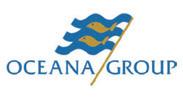

Engen Truck Stop / Denys Edwardes (Pty) Ltd / SMD Telecommunications (Pty) Ltd / Two Oceans Aquarium Trust / NCS Resins / Freddy Hirsch Group / AMSOL / Macs Maritime Carrier Shipping (Pty) Ltd / Marlyn Vulindlela (Pty) Ltd / Ruwekus Fishing (Pty) Ltd / Damen Shipyards Cape Town (Pty) Ltd / Producer Ally (Pty) Ltd / Hoegh Autoliners (Pty) Ltd / Press Spinning & Stamping Co / Mix Telematics International (Pty) Ltd / Cohesive Capital (Pty) Ltd / RF Design / HBS Aluminium Systems (Pty) Ltd / VVM Inc / Marine Solutions / A&M Logistics / Richards Bay Coal Terminal / Barpro Storage SA (Pty) Ltd / Denso SA (Pty) Ltd / Resolve Salvage & Fire (Pty) Ltd / Kiddie Rides / PSG Wealth Financial Planning (Pty) Ltd / AMTEC / Robertson and Caine (Pty) Ltd / Bearfish / Sea Harvest Foundation Trust






Our grateful thanks to DHL for sponsoring the printing of our Integrated Annual Report as well as the jackets for our Station Commanders Conference. To access the IR, please visit nsri.org.za/ who-we-are/annual-reportdownloads-1



TWENTY-SIX NSRI volunteers from Bakoven, Table Bay, Hout Bay, Strandfontein and Simon’s Town took part in a recent Robben Island crossing and raised more than R145 000 for NSRI’s Drowning Prevention programme.
THANK YOU FOR DONATIONS RECEIVED: IN MEMORY OF: Paul Anthony Davison, Geoff Grylls, Ariel Hardy Laurelle, Humphrey Worthington-Smith, Jim Dickens, Helena Perlman, Ray Manning, Bruce Wolov, Roy Gordon Davis, Paul Dellville Mallett IN HONOUR OF: David Robins (birthday), Dave Kilpin (birthday), Ian and Juliet Lomberg (50th wedding anniversary), Mrs Lou Burger (70th birthday), Fasie Malherbe (70th birthday), Poul-Ejnar Hansen (90th birthday)
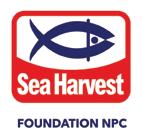
Each year, we pause to reflect on the previous year, review the financials, elect the leadership, recognise the bravery and long-service commitment of our rescue crews, and acknowledge the contribution made by all our donors and supporters. On Friday 22 July, the NSRI celebrated its 55th Annual Awards Evening at Premier Resort The Moorings in Knysna.

› Bravery Bronze: Jurgens Lubbe
For his brave actions on Saturday 9 October 2021 in saving four lives at Cape Vidal Bay, St Lucia, KwaZulu-Natal.
› Bravery Bronze: Humairaa Adam

For the part that she played in rescuing Holly Hedges, 12, shortly after 11h00 on 17 March 2022.
› Station 40 (St Lucia) for the prompt and effec tive action taken by members of the station on 23 October 2021 during the mass rescue of 20 kayakers in rough conditions at Cape Vidal Bay.
Station 5 (Durban)
Station 20 (Shelly Beach)
Station 32 (Port Edward)
Station 39 Rocky Bay
Station 41 Ballito
(St
For the prompt and effective action taken by members of the station to assist, along with the national and local emergency services, in multiple flood-related incidents, along the KwaZulu-Natal coastline and inland, caused by heavy rainfall and the devastating floods in Durban and surrounding areas from 11-13 April 2022.
Directors Letter of Thanks: Tristan Gaylard-Ralf

› Tristan Gaylard-Ralf and Nathan van de Griendt for assisting a man at risk of drowning at Murphys Buffalo Bay Beach on 10 November 2021.
› Clint Craul for the decisive action taken on 9 January 2022 by altering course while aboard Morgan Rose to assist a kayaker in distress off Cape Point.


› Klaus Heinrich for the part that he played in rescuing a Grade 7 and a Grade 8 student from a Swartvlei Beach, on 17 March 2022.
› Zander Hampson and Charné Hirst for assisting four people at risk of drowning at Nahoon Beach on 20 March 2022.

AWARDS
Directors Letter of Thanks: Charné Hirst
Improved Station:
Station:
Bay
Station: Station 25
Dam
Trophy:

Bay
37
Town
Trophy: Simon’s Town
10
› Marmion Marsh Trophy awarded to Ronnie Stein for noteworthy service to the cause of The National Sea Rescue Institute over a number of years.

› Alric Simpson Trophy awarded to Vodacom for distinguished service rendered to the NSRI.


› 20 YEARS
Robert van Helsdingen, Table Bay Myck Jubber, Melkbosstrand Robert van Helsdingen, Wilderness
› 25 YEARS
Hennie Taljaard, Honorary Life Governor June van der Westhuyzen, Head Office Jonathan Tufts, Gqeberha Michael Wilson, Gqeberha Geoff Stephens, Hout Bay Laurent Eray, Plettenberg Bay Pieter Zaayman, Mossel Bay Anton Prinsloo, Strandfontein Garth Shamley, St Francis Bay Charl Haupt, Still Bay
› 30 YEARS
Clifford Ireland, Durban Reinald Hofmeyr, Knysna Berend Maarsingh, Knysna Neville Eustice, Knysna Vaughn Seconds, Strandfontein
The NSRI wishes to thank the following sponsors that helped make our AGM and Awards Evening possible. We appreciate your support: Premier Resort The Moorings, our MC Mark Bayly, DHL for the printing of the Integrated Reports and sponsorship of Station Commander jackets, Connor Thompson for the Audiovisual, Andrew Ingram for capturing the event, Raka Wines, Villiera Wine, Jordan Wine Estate and The Brewery Hemel-en-Aarde.
›
YEARS
Paul Bevis, Durban
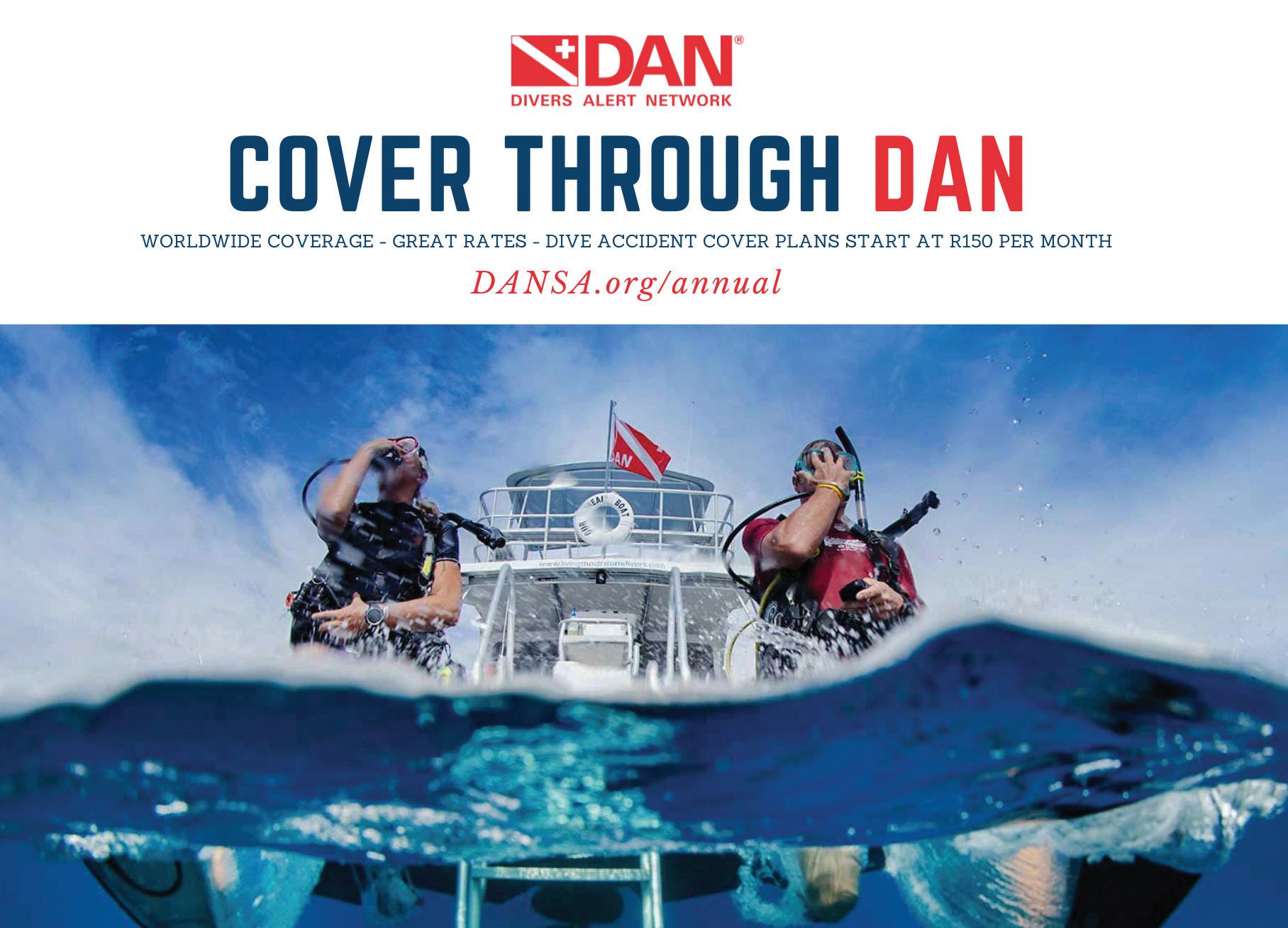
Clint Abrahams, Strandfontein

Saunders, Melkbosstrand
Theresa Medicine, Head Office
Ian Gray, Gqeberha
›
YEARS
›
YEARS
Keith Burchell, Head Office and Honorary Life Governor
Michael Patterson, Richards Bay & Honorary Life Governor

›
YEARS
Brian Hustler, Head Office
This page: Sea spiders are almost all legs. Below: In sea spiders, the fathers carry the developing eggs.
Naturalist Georgina Jones reveals there is so much more to sea spiders than meets the eye.


SEA SPIDERS ARE IN fact not true spiders. Both groups are members of the chelicerates, a subgroup of the arthropods, the vast group of jointedlegged animals that includes insects and crabs, but though they are more closely related to each other than to insects, they are far from being alike, and in fact some genetic research suggests that sea spiders should be considered a sister group to all other arthropods.
It’s not hard to see why. Sea spiders are pretty peculiar.
They have extraordinarily tiny bodies and relatively long legs, a characteristic reflected in the names for the group –Pantopoda or ‘all legs’ and Pycnogonida
Their bodies, in fact, are so small that most metabolic processes have been shunted out into their legs. This means that the digestive system extends into the legs, as do the ovaries: female sea spiders bearing eggs have distinctly thickened leg segments. They have no actual lungs and instead absorb oxygen through their legs. Though they have an anus, they do not appear to have any system for processing and excreting wastes and it is thought that wastes may diffuse out of the body through the exoskeleton.
Sea spiders are known in the fossil record from 500 million years ago and at least 1 300 species are known to exist in the world ocean. Many are small and live in shallow waters – the smallest are so small that their muscles consist of a single cell –but there are large and spectacular deep and polar sea species, some up to 70cm in size. They usually have four pairs of walking legs but some species have five or six pairs. These legs are in addition to the appendages extending from their heads some of which, confusingly, are also known as legs; and some of which, even more confusingly, are used for walking.
They are usually found walking around on the ocean bottom, or concealed under reef animals, though they can sometimes be seen swimming just above the bottom.
They are carnivorous predators or scavengers and are known to eat a variety of soft-bodied prey such as anemones and their relations, sponges, worms, molluscs and moss animals. In the case of anemones, though, since the sea spiders don’t kill them when feeding,
Above: A sea spider with its molluscan prey. Below: Sea spider bodies are so small, most metabolic processes take place in the legs.
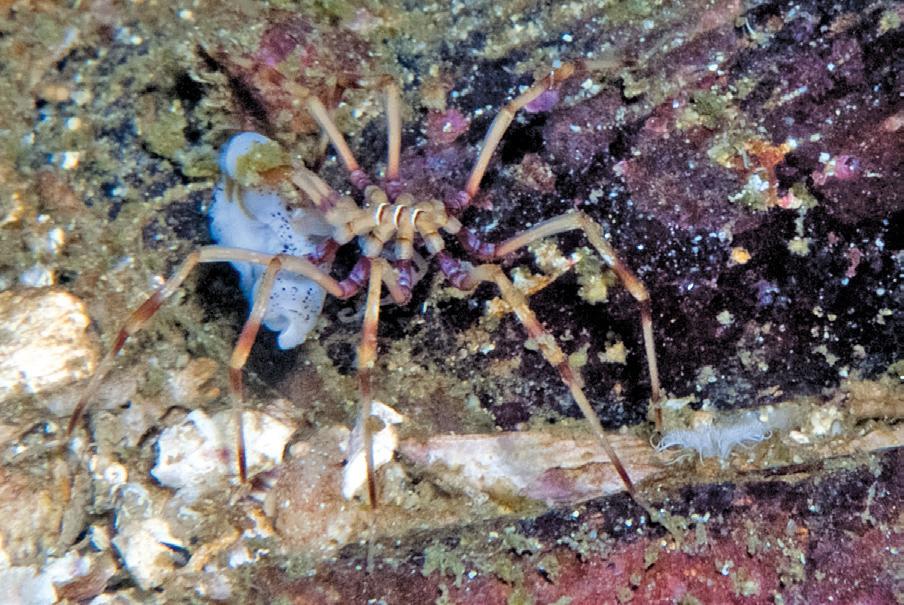
they should be considered more as parasites on anemones.
Sea spiders have a head from which several pairs of appendages extend: the chelifers, used for manipulating prey, the pedipalps, which seem to have a sensory function, but which are sometimes used in walking, and the ovigerous legs, which are not legs at all but instead are used to carry the developing eggs and occasionally larval hatchlings. Depending on the species, some of these appendages may be absent.

They have a long proboscis that is used for piercing and sucking up food. Though they don’t have jaws, the muscles and hard ridges inside the proboscis make it possible for ingested food to be chewed. At the back of the head are up to two pairs of eyes, though these may be non-functional or absent, particularly in deep-sea species.
Like all arthropods, they have long tubular hearts, and these function to distribute their blood to parts of the body. When the blood gets further down the long legs though, it seems to be distributed, along with food, by diffusion and peristalsis.
Reproductively, sea spiders have separate sexes, except for one species which is hermaphrodite. In general, and unlike other arthropods, fertilisation is external. Eggs and sperm emerge from pores at the base of some of the legs. Mating sea spiders will arrange themselves with the male above the female and align their legs so that the pores match up. Once the eggs have been fertilised, the

male broods them, holding them with the ovigerous legs until they hatch.
The larvae themselves are also pretty peculiar, having a gut with no anus, and a body consisting of a head with three pairs of appendages. The rest of the body, the anus and the walking legs develop later.
After hatching, there are at least four modes of larval development, depending on species. The most common is freeliving and gradually develops into the adult form. Some hatch and find an anemone or hydroid host in which to form a cyst and to then develop into the juvenile form, after which they leave their hosts. Others develop on or inside temporary hosts like clams or tube worms. Finally, some develop while attached to their father’s ovigerous legs where they will stay until ready for a free-living existence as a young juvenile with two or three pairs of walking legs.
The remaining pairs of legs, of course, develop later, in tune with their characteristic property of being ‘all legs’.
Sea spiders are most peculiar creatures. Test your knowledge and see how many of the questions you can answer. Don’t peek at the answers.
1. How do sea spiders breathe?
2. How many species of sea spiders are there in the world ocean?
3. Where do sea spiders like to hang out?
4. What do sea spiders like to eat? 5. What do they use to pierce and suck up food?
energy bars
dry vacuum
similar
waterproof
for golf days and
as tea, coffee, sugar
cleaning materials
NORTHERN CAPE
43 063 698 8971 Port Nolloth
WESTERN CAPE
45 066 586 7992 Strandfontein (Matzikama)
24 060 960 3027 Lambert’s Bay
04 082 990 5966 Mykonos
34 082 990 5974 Yzerfontein
18 082 990 5958 Melkbosstrand
03 082 990 5963 Table Bay
02 082 990 5962 Bakoven
08 082 990 5964 Hout Bay
082 990 5979 Kommetjie
29 082 990 5980 Air Sea Rescue
10 082 990 5965 Simon’s Town
16 082 990 6753 Strandfontein
09 072 448 8482 Gordon’s Bay
42 063 699 2765 Kleinmond
17 082 990 5967 Hermanus
38 072 446 6344 Theewaterskloof Dam
30 082 990 5952 Agulhas
33 082 990 5957 Witsand
31 082 990 5978 Still Bay
15 082 990 5954 Mossel Bay
23 082 990 5955 Wilderness
12 082 990 5956 Knysna
14 082 990 5975 Plettenberg Bay
EASTERN CAPE
46 076 092 2465 Storms River
36 082 990 5968 Oyster Bay
082 990 5969 St Francis Bay
37 079 916 0390 Jeffreys Bay
06 082 990 0828 Port Elizabeth
11 082 990 5971 Port Alfred
087 094 9774 Mdumbi [Aux]
47 076 100 2829 Kei Mouth [Aux]
07 082 990 5972 East London
28 082 550 5430 Port St Johns [Aux]
KZN
32 082 990 5951 Port Edward
082 990 5950 Shelly Beach
39 072 652 5158 Rocky Bay
063 699 2687 Ballito
05 082 990 5948 Durban
50 082 990 5948 Umhlanga
19 082 990 5949 Richards Bay
063 699 2722 St Lucia
MPUMALANGA
35 060 962 2620 Witbank Dam
GAUTENG
060 991 9301 Gauteng
NORTH WEST
082 990 5961 Hartbeespoort Dam
FREE STATE
083 626 5128 Vaal Dam
087 094 9774
ABSA Heerengracht Branch code: 506 009
Account number: 1382480607
Account holder: National Sea Rescue Institute Swift code: ABSA-ZA-JJ PAY ONLINE: https://www.nsri.org.za/ support-us/donate



If you choose to do an EFT, please use your telephone number as a unique reference so that we are able to acknowledge receipt, or email your proof of payment to info@searescue.org.za.


Scan this QR code or visit the link below to pay using SnapScan. https://pos.snapscan.io/qr/ STB4C055
Please use your cellphone number as base/project reference so we can acknowledge your donation.
Scan this QR code or visit the link below to pay using Zapper. https://www.zapper.com/ url/KU1oB
Please use your cellphone number as base/project reference so we can acknowledge your donation.



